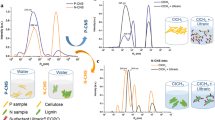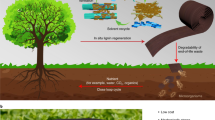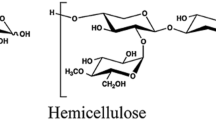Abstract
Renewable and biodegradable materials derived from biomass are attractive candidates to replace non-biodegradable petrochemical plastics. Bioplastics have gained the attention as great alternative to unsustainable traditional plastics and to lower carbon footprint. However, the mechanical performance and wet stability of biomass are generally insufficient for practical applications. In this study, we present a simple approach for producing high-performance biodegradable plastic from lignocellulosic plant-based resources such as Musa paradisiaca Linn (banana), Hibiscus rosasinensis (hibiscus), Mangifera indica (mango) and Prunus dulcis (almond) using in situ lignin regeneration. In this approach, the homogenous cellulose-chitosan slurry is formed by the deconstruction of leaves collected from these plants. Cellulosic bioplastic materials were produced by hydrogen bonding among acetylated cellulose, carboxymethylated chitosan, and glycerol. In SEM images, the natural lignocellulose shows a honeycomb-like structure. Additionally, it exhibits high mechanical properties, with Chi-Hi containing higher percentages (52–59%) of cellulose in bast fiber, better water stability, and thermal stability. In contrast, Chi-Mos exhibits a higher 90° θ water contact angle. Furthermore, all fabricated bioplastics have synchronous melting temperatures of 257 ± 1.3 °C. Moreover, lignocellulosic bioplastic has a lower environmental impact due to its simple recycling or secure biodegradability, resulting in an average mass loss of 35.67% after 15 days.
Graphical Abstract
Fabrication of Chitosan reinforced bioplastic with nature-based topology










Similar content being viewed by others
Data Availability
Data will be made available on request.
References
Dang, B.-T., et al.: Current application of algae derivatives for bioplastic production: A review. Biores. Technol. 347, 126698 (2022)
Ghosh, K., Jones, B.H.: Roadmap to biodegradable plastics—Current state and research needs. ACS Sustain. Chem. Eng. 9(18), 6170–6187 (2021)
Kim, H., et al.: Toward sustaining bioplastics: Add a pinch of seasoning. ACS Sustain. Chem. Eng. 11(5), 1846–1856 (2023)
Thakur, S., et al.: Sustainability of bioplastics: Opportunities and challenges. Curr. Opin. Green Sustain. Chem. 13, 68–75 (2018)
Zhao, X., Cornish, K., Vodovotz, Y.: Narrowing the gap for bioplastic use in food packaging: An update. Environ. Sci. Technol. 54(8), 4712–4732 (2020)
Celis, J.E., et al.: Plastic residues produced with confirmatory testing for COVID-19: Classification, quantification, fate, and impacts on human health. Sci. Total. Environ. 760, 144167 (2021)
Mohan, G., Johnson, R.L., Yu, J.: Conversion of pine sawdust into polyhydroxyalkanoate bioplastics. ACS Sustain. Chem. Eng. 9(25), 8383–8392 (2021)
Blilid, S., et al.: Phosphorylated micro- and nanocellulose-filled chitosan nanocomposites as fully sustainable, biologically active bioplastics. ACS Sustain. Chem. Eng. 8(50), 18354–18365 (2020)
Vollmer, I., et al.: Beyond mechanical recycling: Giving new life to plastic waste. Angew. Chem. Int. Ed. Engl. 59(36), 15402–15423 (2020)
Vethaak, A.D., Legler, J.: Microplastics and human health. Science 371(6530), 672–674 (2021)
Padil, V.V.T., et al.: Bioplastic fibers from gum Arabic for greener food wrapping applications. ACS Sustain. Chem. Eng. 7(6), 5900–5911 (2019)
Ali, S.S., et al.: Bioplastic production in terms of life cycle assessment: A state-of-the-art review. Environ. Sci. Ecotechnol. 15, 100254 (2023)
Kawaguchi, H., et al.: Recent advances in lignocellulosic biomass white biotechnology for bioplastics. Biores. Technol. 344, 126165 (2022)
Zhao, X., et al.: Sustainable bioplastics derived from renewable natural resources for food packaging. Matter 6(1), 97–127 (2023)
Filho, W.L., et al.: An assessment of attitudes towards plastics and bioplastics in Europe. Sci. Total Environ. 755, 142732 (2021)
Nandakumar, A., Chuah, J.-A., Sudesh, K.: Bioplastics: A boon or bane? Renew. Sustain. Energy Rev. 147, 111237 (2021)
Rosenboom, J.-G., Langer, R., Traverso, G.: Bioplastics for a circular economy. Nat. Rev. Mater. 7(2), 117–137 (2022)
Xia, Q., et al.: A strong, biodegradable and recyclable lignocellulosic bioplastic. Nat. Sustain. 4(7), 627–635 (2021)
Suzuki, S., et al.: Green conversion of total lignocellulosic components of sugarcane bagasse to thermoplastics through transesterification using ionic liquid. ACS Sustain. Chem. Eng. 9(45), 15249–15257 (2021)
Brodin, M., et al.: Lignocellulosics as sustainable resources for production of bioplastics—A review. J. Clean. Prod. 162, 646–664 (2017)
Erdal, N.B., Hakkarainen, M.: Degradation of cellulose derivatives in laboratory, man-made, and natural environments. Biomacromolecules 23(7), 2713–2729 (2022)
Wilson, D.B.: Three microbial strategies for plant cell wall degradation. Ann. NY Acad. Sci. 1125(1), 289–297 (2008)
Teeri, T.T.: Crystalline cellulose degradation: New insight into the function of cellobiohydrolases. Trends Biotechnol. 15(5), 160–167 (1997)
Béguin, P., Aubert, J.-P.: The biological degradation of cellulose. FEMS Microbiol. Rev. 13(1), 25–58 (1994)
Kusumastuti, Y., et al.: Effect of chitosan addition on the properties of low-density polyethylene blend as potential bioplastic. Heliyon 6(11), e05280 (2020)
Raj, T., et al.: Lignocellulosic biomass as renewable feedstock for biodegradable and recyclable plastics production: A sustainable approach. Renew. Sustain. Energy Rev. 158, 112130 (2022)
Zhou, L., et al.: Recent progress on chemical modification of cellulose for high mechanical-performance poly(lactic acid)/cellulose composite: A review. Compos. Commun. 23, 100548 (2021)
Bhardwaj, S., Bhardwaj, N.K., Negi, Y.S.: Effect of degree of deacetylation of chitosan on its performance as surface application chemical for paper-based packaging. Cellulose 27(9), 5337–5352 (2020)
Zhang, H., Su, Z., Wang, X.: Starch-based rehealable and degradable bioplastic enabled by dynamic imine chemistry. ACS Sustain. Chem. Eng. 10(26), 8650–8657 (2022)
Lei, C., et al.: Large-scale manufacture of recyclable bioplastics from renewable cellulosic biomass derived from softwood Kraft pulp. ACS Appl. Polym. Mater. 4(2), 1334–1343 (2022)
Zhu, L., et al.: Transparent bioplastics from super-low lignin wood with abundant hydrophobic cellulose crystals. ACS Sustain. Chem. Eng. 10(41), 13775–13785 (2022)
Zhou, Y., et al.: Sustainable, high-performance, and biodegradable plastics made from chitin. ACS Appl. Mater. Interfaces. 14(41), 46980–46993 (2022)
Lee, K., et al.: Double-crosslinked cellulose nanofiber based bioplastic films for practical applications. Carbohyd. Polym. 260, 117817 (2021)
Jiang, D.-H., et al.: Sustainable alternatives to nondegradable medical plastics. ACS Sustain. Chem. Eng. 10(15), 4792–4806 (2022)
Yang, H., Sheikhi, A., van de Ven, T.G.M.: Reusable green aerogels from cross-linked hairy nanocrystalline cellulose and modified chitosan for dye removal. Langmuir 32(45), 11771–11779 (2016)
Beltrán-Sanahuja, A., et al.: Monitoring polymer degradation under different conditions in the marine environment. Environ. Pollut. 259, 113836 (2020)
Tanaka, S., Iwata, T., Iji, M.: Long/short chain mixed cellulose esters: effects of long acyl chain structures on mechanical and thermal properties. ACS Sustain. Chem. Eng. 5(2), 1485–1493 (2017)
Malm, C.J., et al.: Relative rates of acetylation of the hydroxyl groups in cellulose acetate. J. Am. Chem. Soc. 75(1), 80–84 (1953)
Onwuka, J.C., et al.: Thermodynamic pathway of lignocellulosic acetylation process. BMC Chem. 13(1), 79 (2019)
Tang, X., et al.: Effects of functional groups of –NH2 and –NO2 on water adsorption ability of Zr-based MOFs (UiO-66). Chem. Phys. 543, 111093 (2021)
Jin, S.G., et al.: Influence of hydrophilic polymers on functional properties and wound healing efficacy of hydrocolloid based wound dressings. Int. J. Pharm. 501(1), 160–166 (2016)
Guzman-Puyol, S., et al.: Greaseproof, hydrophobic, and biodegradable food packaging bioplastics from C6-fluorinated cellulose esters. Food Hydrocolloids 128, 107562 (2022)
Masek, A., Diakowska, K., Zaborski, M.: Physico-mechanical and thermal properties of epoxidized natural rubber/polylactide (ENR/PLA) composites reinforced with lignocellulose. J. Therm. Anal. Calorim. 125(3), 1467–1476 (2016)
Szcześniak, L., Rachocki, A., Tritt-Goc, J.: Glass transition temperature and thermal decomposition of cellulose powder. Cellulose 15, 445–451 (2008)
Zhang, M., et al.: Identification of biodegradable plastics using differential scanning calorimetry and carbon composition with chemometrics. J. Hazard. Mater. Adv. 10, 100260 (2023)
Ruvolo-Filho, A., Curti, P.S.: PET recycled and processed from flakes with different amount of water uptake: characterization by DSC, TG, and FTIR-ATR. J. Mater. Sci. 43(4), 1406–1420 (2008)
Vey, E., et al.: The impact of chemical composition on the degradation kinetics of poly(lactic-co-glycolic) acid copolymers cast films in phosphate buffer solution. Polym. Degrad. Stab. 97, 358–365 (2012)
Mohagheghian, I., McShane, G.J., Stronge, W.J.: Impact perforation of monolithic polyethylene plates: Projectile nose shape dependence. Int. J. Impact Eng. 80, 162–176 (2015)
Lam, T.B.T., Hori, K., Iiyama, K.: Structural characteristics of cell walls of kenaf (Hibiscus cannabinus L.) and fixation of carbon dioxide. J. Wood Sci. 49(3), 255–261 (2003)
Genet, M., et al.: The influence of cellulose content on tensile strength in tree roots. Plant Soil 278(1/2), 1–9 (2005)
Tan, S.X., et al.: Characterization and parametric study on mechanical properties enhancement in biodegradable chitosan-reinforced starch-based bioplastic film. Polymers 14, 278 (2022). https://doi.org/10.3390/polym14020278
Zhang, J., et al.: 3D Porous structure-inspired lignocellulosic biosorbent of medulla tetrapanacis for efficient adsorption of cationic dyes. Molecules 27(19), 6228 (2022)
Acknowledgements
The authors thank the National Institute of Technology, Raipur (Chhattisgarh), India, for financially supporting this work and infrastructure. Chinmaya Mahapatra acknowledges the National Institute of Technology Raipur for Seed Grant, Project No: NITRR/Seed Grant/2021-22/30.Chinmaya Mahapatra also gratefully acknowledged research support from the Department of Science and Technology, INDIA, Science & Engineering Research Board (SERB) Sanction Order No. SRG/2022/000348. The authors thank undergraduate students C.Smitha,Komal Verma and UshaSree Pandranki for their support in this research.
Funding
CM acknowledges the National Institute of Technology Raipur for Seed Grant, Project No: NITRR/Seed Grant/2021-22/30.CM gratefully accepted the research support of Science & Engineering Research Board (SERB) vide grant number SRG/2022/000348 from the Department of Science and Technology, India.
Author information
Authors and Affiliations
Corresponding authors
Ethics declarations
Conflict of interest
The authors do not have any conflict of interest.
Ethical Approval
Not applicable.
Consent to Participate
Not applicable.
Consent to Publish
Not applicable.
Additional information
Publisher's Note
Springer Nature remains neutral with regard to jurisdictional claims in published maps and institutional affiliations.
Supplementary Information
Below is the link to the electronic supplementary material.
Rights and permissions
Springer Nature or its licensor (e.g. a society or other partner) holds exclusive rights to this article under a publishing agreement with the author(s) or other rightsholder(s); author self-archiving of the accepted manuscript version of this article is solely governed by the terms of such publishing agreement and applicable law.
About this article
Cite this article
Chandra, D.K., Kumar, A. & Mahapatra, C. Fabricating Chitosan Reinforced Biodegradable Bioplastics from Plant Extract with Nature Inspired Topology. Waste Biomass Valor 15, 2499–2512 (2024). https://doi.org/10.1007/s12649-023-02293-3
Received:
Accepted:
Published:
Issue Date:
DOI: https://doi.org/10.1007/s12649-023-02293-3




